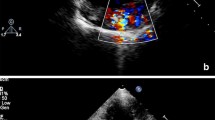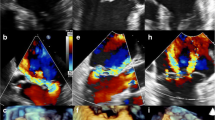Abstract
Acute severe mitral regurgitation (MR) is rare, but often leads to cardiogenic shock, pulmonary edema, or both. Most common causes of acute severe MR are chordae tendineae (CT) rupture, papillary muscle (PM) rupture, and infective endocarditis (IE). Mild to moderate MR is often seen in patients with acute myocardial infarction (AMI). CT rupture in patients with floppy mitral valve/mitral valve prolapse is the most common etiology of acute severe MR today. In IE, native or prosthetic valve damage can occur (leaflet perforation, ring detachment, other), as well as CT or PM rupture. Since the introduction of percutaneous revascularization in AMI, the incidence of PM rupture has substantially declined. In acute severe MR, the hemodynamic effects of the large regurgitant volume into the left atrium (LA) during left ventricular (LV) systole, and in turn back into the LV during diastole, are profound as the LV and LA have not had time to adapt to this additional volume. A rapid, but comprehensive evaluation of the patient with acute severe MR is essential in order to define the underline cause and apply appropriate management. Echocardiography with Doppler provides vital information related to the underlying pathology. Coronary arteriography should be performed in patients with an AMI to define coronary anatomy and need for revascularization. In acute severe MR, medical therapy should be used to stabilize the patient before intervention (surgery, transcatheter); mechanical support is often required. Diagnostic and therapeutic steps should be individualized, and a multi-disciplinary team approach should be utilized.



Similar content being viewed by others
Availability of data and materials
Not applicable.
References
Boudoulas H, Wooley CF (1991) Mitral regurgitation-chronic versus acute: implications for timing of surgery. In Contemporary Internal Medicine. Clinical Case Studies, Volume 3. Bowen JM, Mazzaferri AL (eds). Plenum Publishing Corporation, pp 1–35
Harb SC, Griffin BP (2017) Mitral valve disease: a comprehensive review. Curr Cardiol Rep, Valvular Hear Dis
Boudoulas H, Wooley CF (eds) (2000) Mitral Valve: floppy mitral valve, mitral valve prolapse, mitral valvular regurgitation. Second revised edition; Futura Publishing Company Inc
Thomson CR, Buller CE, Sleeper LA et al (2000) Cardiogenic shock due to acute severe mitral regurgitation complicating acute myocardial infarction; a report from the SHOCK Trial Registry: should we emergently revascularize Occluded Coronaries in cardiogenic shock? J Am Coll Cardiol 36(suppl A):1104–1109
Stout KK, Verrier ED (2009) Acute valvular regurgitation. Circulation 119:3232–3241
Xanthopoulos A, Butler J, Parissis J, Polyzopoulou E, Skoularigis J, Triposkiadis F (2020) Acutely decompensated versus acute heart failure: two different entities. Heart Fail Rev 25:907–916
Boudoulas KD, Borer JS, Boudoulas H (2013) Etiology of valvular heart disease in the 21st century. Cardiology 126:139–152
Gabbay U, Yosely C (2010) The underlying causes of chordae tendineae rupture: a systematic review. Intern J Cardiol 143:113–118
Nishino S, Watanabe N, Kimura T et al (2016) The course of ischemic mitral regurgitation in acute myocardial infarction after primary percutaneous coronary intervention. Circ Cardiovasc Imaging
Bursi F, Enriquez-Sarano M, Nkomo VT et al (2005) Heart failure and death after myocardial infarction in the community. The emerging role of mitral regurgitation. Circulation 111:295–301
Sannino A, Greyburn PA (2016) Ischemic mitral regurgitation after acute myocardial infarction in the percutaneous coronary intervention era. Circ Cardiovasc Imaging 9:e005323
Angelini A, Ho SY, Thiene G, Anderson RH (2000) Anatomy of the mitral valve. In Mitral Valve. Boudoulas H, Wooley CF (eds) Second revised edition; Futura Publishing Company Inc. pp 5–29
Davies MJ, Moore PB, Brainridge MV (1978) The floppy mitral valve; incidence, pathology, and complications in surgical, necropsy, and forensic material. Br Heart J 40:468–481
Boudoulas KD, Pitsis A, Mazzaferri EL, Gunina RJ, Triposkiadis F, Boudoulas H (2020) Floppy mitral valve/mitral valve prolapse: a complex entity with multiple genotypes and phenotypes. Progr Cardiovasc Dis 63:308–326
Boudoulas KD, Pitsis A, Boudoulas H (2016) Floppy mitral valve (FMV)- mitral valve prolapse (MVP)-mitral valvular regurgitation and the FMV/MVP syndrome. Hellenic J Cardiol 57:73–85
Olson LJ, Subramanian R, Ackermann DM, Orszulak TA, Edwards WD (1987) Surgical pathology of the mitral valve: a study of 712 cases spanning 21 years. Mayo Clin Proc 62:22–34
Gridioni F, Enriquez-Sarano M, Ling LH et al (1999) Sudden death in mitral regurgitation due to flail leaflet. J Am Coll Cardiol 34:2078–2085
Maron MS, Olivotto I, Harrigan C et al (2011) Mitral valve abnormalities identified by cardiovascular magnetic resonance represent a primary phenotypic expression of hypertrophic cardiomyopathy. Circulation 124:4047
Boissier F, Achkouty G, Bruneval R et al (2015) Rupture of mitral valve chordae in hypertrophic cardiomyopathy. Arch Cardiov Dis 108:244–249
Chin FH, Yang CJ, Huag CK et al (2018) Spontaneous chordae tendineae rupture during pregnancy. Am J Emerg Med 36:1127.e1–1127e3
Shiraishi I, Nishimura K, Sakaguchi H et al (2014) Acute chordae tendineae rupture of the mitral valve in infants: a nationwide survey in Japan exploring a new syndrome. Circulation 130:1053–1061
Torigoe T, Sakaguchi H, Kitamo M et al (2012) Clinical characteristics of acute mitral regurgitation due to rupture chordae tendineae in infancy-experience of a single institution. Eur J Pediatr 171:259–265
Simmons TA, Meijburg AW, de Riviere AB (2001) Traumatic papillary muscle rupture. Ann Thor Surg 72:257–259
Watanabe N (2019) Acute mitral regurgitation. Heart 105:671–677
Lanz J, Wyss D, Rober L et al (2019) Mechanical complications in patients with ST segment elevation myocardial infarction: a single center experience. PLoS ONE 14:e0209502
Damluzi A, van Diepen S, Katz JN et al (2021) Mechanical complications of acute myocardial infarction. A scientific statement of the American Heart Association. Circulation 144(issue 2):e16–235
Baddour LM, Wilson WR, Bayer AS et al (2015) Infective endocarditis in adults: diagnosis, antimicrobial therapy, and management of complications: a scientific statement for healthcare professionals from the American Heart Association. Circulation 132:1435–1486
Roman JA, Vilacosta I, Lopez J, Sarria C (2015) Critical questions about left-sided infective endocarditis. J Am Coll Cardiol 66:1068–1076
Murdoch DR, Corey GR, Hoen B et al (2009) Clinical presentation, etiology and outcome of infective endocarditis in the 21st century: the international collaboration on endocarditis prospective cohort study. Arch Int Med 169:463–473
Simard T, Vemulapalli S, Jung RG et al (2022) Transcatheter edge-t-edge mitral valve repair in patients with severe mitral regurgitation and cardiogenic shock. J Am Coll Cardiol 80:2072–2084
Tang GHL, Estevez-Loureiro R, Yu Y et al (2021) Survival following edge-to-edge transcatheter mitral valve repair in patients with cardiogenic shock: a nationwide analysis. J Am Heart Assoc 10:e019882
Haberman D, Estevez-Loureiro R, Benito-Gonzalez T et al (2022) Conservative, surgical, and percutaneous treatment for mitral regurgitation shortly after acute myocardial infarction. Eur Heart J 43:641–650
Boudoulas KD, Paraskevaides I, Boudoulas H, Triposkiadis FK (2014) The left atrium: from the research laboratory to the clinic. Cardiology 129:1–1
Boudoulas H, Gravanis MB (1993) Valvular heart disease. In Cardiovascular Disorders: pathogenesis and pathophysiology. Mosby-Year Book, Inc, Gravanis MB, ed. pp 64–117
Otto CM, Nishimura RA, Bonow RO et al (2021) 2020 ACC/AHA Guidelines for the management of patients with valvular heart disease: executive summary. A report of the American College of Cardiology/ American Heart Association Joint Committee on clinical practice guidelines. Circulation 143:e35–e71
Zeymer U, Alushi B, Noc N et al (2023) Influence of culprit lesion intervention on outcome in infasrct- related cardiogenic shock with cardiac arrest. F Am Coll Cardiol 81:1165–1176
Russo A, Suri RM, Gredioni F et al (2008) Clinical outcome after surgical correction of mitral regurgitation due to papillary muscle rupture. Circulation 118:1528–2153
Lorusso R, Gelsomino S, De Cicco G et al (2008) Mitral valve surgery in emergency for severe acute regurgitation: analysis of postoperative results from a multicenter study. Eur J Cardio-Thoracic Surg 33:573–582
Geis N, Raake P, Mereles D et al (2017) Percutaneous repair of severe mitral regurgitation secondary to chordae rupture in octogenarians using mitral clip. Interventional Cardiol 31:76–82
Sultan I, Aranta-Michel E, Gleason TG et al (2018) Mitral valve surgery for acute papillary muscle rupture. J Cardiac Surg 33:844–848
Jalil B, El-Kersh K, Frizzell J et al (2017) Impella percutaneous left ventricular assist device for severe acute ischemic mitral regurgitation as a bridge to surgery. BMJ Case Rep 2017:bcr2017219749
Vandenbriele C, Balthazar T, Wilson J et al (2021) Left Impella device as bridge from cardiogenic shock with acute, severe mitral regurgitation to MitraClip-procedure: a new option for critically ill patients. Eu Heart J Acute Cardiovasc Care 10:415–421
Parlow S, Di Santo P, Jung RG et al (2022) Transcatheter mitral valve repair for inotropic dependent cardiogenic shock-designed and rational of the CAPITAL MINOS trial. Am Heart J 254:81–87
Adamo M, Curello S, Chiari E et al (2017) Percutaneous edge-to- edge mitral valve repair for the treatment of acute mitral regurgitation complicating myocardial infarction: as single center experience. Int J Cardiol 234:53–57
Mack M, Carroll JD, Thourani V et al (2021) Transcatheter mitral valve therapy in the United States: a report from the STS-ACT TVT registry. J Am Coll Cardiol 78:2326–2353
Author information
Authors and Affiliations
Contributions
KDB and HB literature review, interpretation of data, writing first draft, critical revisions; FP, SK, KM, CI, and AP literature review, interpretation of data, writing, and critical revisions.
Corresponding author
Ethics declarations
Ethical approval
Not applicable.
Competing interests
The authors declare no competing interests.
Additional information
Publisher's Note
Springer Nature remains neutral with regard to jurisdictional claims in published maps and institutional affiliations.
Rights and permissions
Springer Nature or its licensor (e.g. a society or other partner) holds exclusive rights to this article under a publishing agreement with the author(s) or other rightsholder(s); author self-archiving of the accepted manuscript version of this article is solely governed by the terms of such publishing agreement and applicable law.
About this article
Cite this article
Boudoulas, K.D., Triposkiadis, F., Koenig, S. et al. Acute mitral regurgitation with and without acute heart failure. Heart Fail Rev 28, 1201–1209 (2023). https://doi.org/10.1007/s10741-023-10322-5
Accepted:
Published:
Issue Date:
DOI: https://doi.org/10.1007/s10741-023-10322-5




